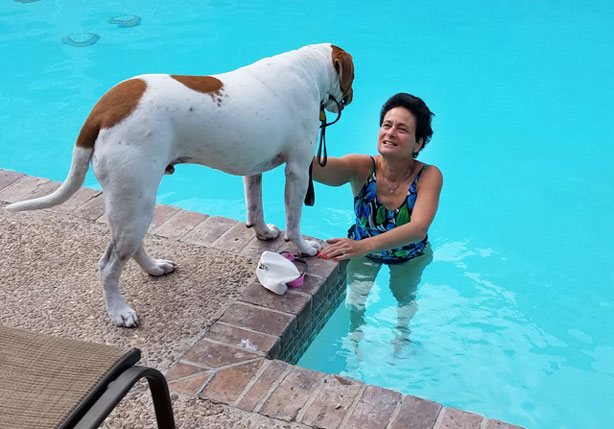Swimming Pool Discrimination:
The Facts and Your Rights

If you have an ostomy, you have the same rights as any other person to swim in the pool facility of your choice. There is a recurring issue with people living with an ostomy being improperly denied access to a swimming pool because of their ostomy. Please utilize the following self-advocacy resources below to help resolve the situation at your pool facility:
If you have exhausted all courses of action including using the above resources and continue to be denied access to your pool facility, please be aware that according to the Americans with Disabilities Act (ADA) this is discrimination and you are protected. You may consider filing a complaint.
Private Residential Facility/Housing Development Pool
If you are being denied access to a private residential facility/housing development pool, such as a Condominium Association, you are protected under the Fair Housing Act. The Office of Fair Housing and Equal Opportunity administratively enforces the Fair Housing Act (the Act).
“One type of disability discrimination prohibited by the Act is the refusal to make reasonable accommodations in rules, policies, practices, or services when such accommodations may be necessary to afford a person with a disability the equal opportunity to use and enjoy a dwelling.”
A complaint must be filed within a year of the alleged discriminatory act.
You can file a complaint with HUD (the Department of Housing and Urban Development) by telephone at 1-800-669-9777 or online here:
Public Pool
If you are being denied access to a public facility in your state or local town, you are protected under the Americans with Disabilities Act (ADA).
You can file a complaint with the U.S. Department of Justice. Visit www.ada.gov or call 1-800-514-0301.
Individual states where action has already taken place and this issue addressed:
 After healing from ostomy surgery, people of all ages and types enjoy swimming, surfing scuba diving or just relaxing in a hot tub. We understand the anxiety from worrying about leaks can keep some people out of the pool. There are no ostomy specific restrictions to swimming in public places. “Swimming has made me stronger both physically and emotionally. It is a great outlet and has made me even healthier. I feel and look more beautiful” says Lynn Wolfson of Florida. Lynn has two ostomies and swims in triathlons. Here are some solutions to common concerns.
After healing from ostomy surgery, people of all ages and types enjoy swimming, surfing scuba diving or just relaxing in a hot tub. We understand the anxiety from worrying about leaks can keep some people out of the pool. There are no ostomy specific restrictions to swimming in public places. “Swimming has made me stronger both physically and emotionally. It is a great outlet and has made me even healthier. I feel and look more beautiful” says Lynn Wolfson of Florida. Lynn has two ostomies and swims in triathlons. Here are some solutions to common concerns.
I’m afraid that my pouch will leak or my wafer will loosen while I’m in the water.
Remember, your pouching system is resistant to water and with a proper fit, it is designed not to leak. If you have output concerns, eat a few hours before swimming. A good habit is to empty your pouch before taking a dip. If you are hesitant about how your wafer will hold, take a practice soak in your bathtub. It is best to avoid applying a new skin barrier/wafer or pouch right before swimming. The WOCN Society recommends allowing 12 hours for proper adhesion. Using waterproof tape or water-specific barrier strips are not necessary for most, but can provide peace of mind. There are a wide variety of ostomy supplies on the market for swimming and you should be able to find a solution that works best for you. If your pouch has a vent, use the provided sticker over the air hole so that the filter remains effective.
What can I wear or do to help conceal my pouch and keep it secure?
Wearing a patterned or darker color is less transparent than a light-colored swim garment. Options for women include patterned and boyleg one-piece suits. For a two-piece suit, consider a mix and match of tankini tops, high-waisted bottoms or boy shorts. You can also look for a suit with a concealing ruffle or skirt. Men often favor a higher cut waist for trunks, or suits with longer legs. Stretch fabric undergarments and swim or surf shirts also provide support. Ostomy bands and wraps are also commonly used. On the beach or poolside don’t be surprised to know that some ostomates are comfortable with simply wearing the swimsuit of their choice- with swim fabric pouch covers or just an opaque pouch. There is also swimwear and accessories specifically made for ostomates by a variety of manufacturers.
What do I do if I am approached by pool personnel concerned that my ostomy is an open wound or believe ostomy pouches are not allowed in pools?
The best approach here is to stay calm and try to educate. However, unless you or another person tell pool personnel, no one should know you have an ostomy. Contact UOAA Advocacy Manager, Jeanine Gleba if this is a recurring issue at your swim location. The Americans with Disabilities Act ensures your right to pool access and most disagreements can be solved through education before exploring any legal recourse. Some scuba diving operations also incorrectly list having an ostomy as an exclusion on pre-dive paperwork. Contacting PADI (800) 729-7234 can help educate them that there is no reason to avoid diving if you have an ostomy pouch.
Meet with a WOC nurse for questions about what supplies may work best for you and stop by your local UOAA Affiliated Support Group or visit our discussion board at ostomy.org to ask what your peers do to feel confident and secure while swimming.